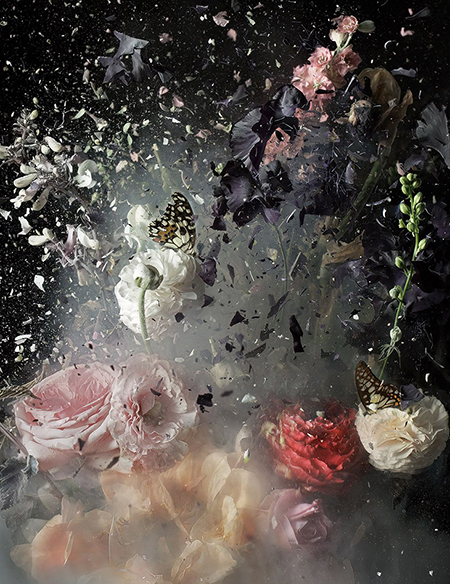
Continuing through March 25, 2023
This exhibition combines several bodies of Ori Gersht’s work, a fine art photographer born in Israel and based in London. Active for over two decades, Gersht’s photographs capture a contemporary view of the history of painting via two of its most traditional genres, landscapes and still lifes. His newest series, “Fields and Visions” (2022), reveals Gersht’s interest in nature in general, and botanical themes in particular, through a preoccupation with two historical figures who looked at South America: the Swiss naturalist Maria Sibylla Merian, who traversed Dutch Guiana in the 17th century to study plants and insects; and the paintings of Martin Johnson Heade, who travelled the Amazon during the 19th century in search of orchids and hummingbirds.
This new body of work is on view for the first time, together with an earlier series of convoluted landscapes titled “Floating World” (2016). Also on view are works from the series “Floating Time” (2022), which features blurry and chaotic still lifes, and a video installation, “Waveform” (2022), that features three flat screens installed in a darkened room.
In all of these, Gersht begins with a found or even captured image and proceeds to manipulate it. The surrounding spaces are transformed with artificial intelligence software. Extra information fills in the gaps of the original low resolution starting point, altering and augmenting the color values and clarity. The result is imbued with astonishing detail and vibrant energy.
This working method allows the artist to demonstrate how images can illustrate historical processes related to disintegration through the passing of time. Metaphorically, these decompositions suggest the detritus left over from the material tendency to obsolescence inherent within the capitalist system. This, in turn, infers the possibility of renewal through a recombination of elements that could pave the way toward revolutionary change.
The “Fields and Visions” series reveals these changing relationships in terms of photography’s evolution. By now the medium has moved well beyond its early formal mandate to depict things as they are, and now ventures into a conceptual realm where it creates its own illusory reality. “Fields and Visions #5” features floral elements that occupy a central place within the panel, radiating outward, but grounded within a flat, black background. Here, Gersht’s floral motifs seem to float over a reflective or mirrored pool at the lower section.
In “Fields and Visions #1” it’s as if the floral elements have begun to explode, separating like a celestial big bang within a realm filled with smoke-like space dust. In “Fields and Visions #2” the process of disintegration is taken to the next order, with the floral fragments all but unrecognizable, filling the image with debris like an abstract splatter painting made of plant specimens and flower petals.
In “Untitled 01” and “Untitled 04 (Fusing Time)” the floral elements are larger, presented in a softer focus that is slightly blurry. The plants thus appear more verdant and less detailed that those of “Fields and Visions.” Approaching the three dimensional, this series features a depth of field that recedes beyond the outward surface, in contrast to the other series. The “Untitled” works are ethereal in a way that suggests a fullness of being, as if they’re constantly changing and evolving without a hint of annihilation.
The “Waveform” videos are each dedicated to a single plant, respectively titled “Shoka Yellow,” “Rikka,” and “Shoka Purple.” They depict an “image disappears” moment stretched out to an excruciating four minutes and forty-one seconds. In each video the floral elements sit within the center of the image, bisected and mirrored by a reflection in a pool of water such that the flowers and their reflection each take up half of the vertical field. Slowly and methodically, water begins to rain down over the flora, engulfing them completely until they finally disappear, leaving a calm and empty space where the plants once were. Then the entire process begins again.
With the ruins-of-history metaphor proposed in “Fields and Visions,” we have a strong hint of Walter Benjamin’s theory of history that fused the Jewish notion of Tikkun Olam (repair the world) with the release of repressed collective memory. For their part, “Waveform” videos advance Friedrich Nietzsche’s Ewige Wiederkunft, or Eternal Recurrence, a cyclical conception of reality. Gersht’s subject matter may be traditional, but his treatment leads us to reflect on some very large issues.
